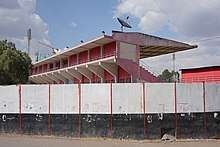Addis Ababa Stadium
 | |
| Full name | Yidnekachew Tessema Stadium |
|---|---|
| Former names | Haile Selassie Stadium |
| Location | Addis Ababa, Ethiopia |
| Capacity | 35,000 |
| Surface | Grass |
| Construction | |
| Opened | 1940 |
| Renovated | 1960, 1999 |
| Tenants | |
|
Ethiopia national football team Saint George FC Ethiopian Coffee FC Defence FC | |
Addis Ababa Stadium is a multi-purpose stadium in Addis Ababa, Ethiopia. It is used mostly for football matches although it also has athletics facilities. The stadium has a capacity of 35,000 people.
History
Addis Ababa Stadium was constructed in 1940. It hosted several matches during the 1962, 1968 and 1976 African Cup of Nations, including the final of the 1962 (won by Ethiopia over the United Arab Republic) and 1968 editions and the final group stage of the 1976 tournament.
Later in 1999, it was renovated for the 2001 CAF African Youth Championship held in Ethiopia. In this championship, the Ethiopia's National Youth team came fourth. The Ethiopian youth team thereby qualified for the first time for the 2001 FIFA World Youth Championship that took place in Argentina.
Addis Ababa Stadium is located at the heart of Addis Ababa near Legehar train station and Meskel Square. The stadium hosts both international soccer and athletics competitions. Great athletes like the legendary Abebe Bikila and Haile Gebrselassie have competed at the stadium. According to IAAF certification, Addis Ababa stadium has Class II certificate for its athletics facilities. Between 30 April and 4 May 2008, Addis Ababa Stadium hosted the 16th African Athletics Championships.
Stands
The small section immediately to the right of the main stand was called "Kemeneshe" while the stand in the right corner of the stadium was called "Abebe Bikila" due to the fact that there was a shop with the same name under stands on the exterior side.
The stands to the left of the main stand was called "Fasika Ber", named after advertisements displayed in this section of the stadium. The section immediately to the left of this was called "Tesera".
The stands opposite of the main stand are historically known as "Katanga", alluding to the military personal that used to sit in these stands after returning from peace keeping missions in Katanga, DRC.
The stadium has 12 entrance tunnels.
Future
Construction on a new FIFA and Olympic-standard 60,000 seat stadium is due in 2019. LAVA, DESIGNSPORT and local Ethiopian firm JDAW won the international competition held by the Federal Sport Commission, Ethiopia to design the stadium and sports village. The design combines local identity, such as rock cut architecture and the massob basket,[1] with new technology.[2] The stadium is being built by the China State Construction Engineering.
References
External links
Coordinates: 9°0′47.9″N 38°45′23.1″E / 9.013306°N 38.756417°E